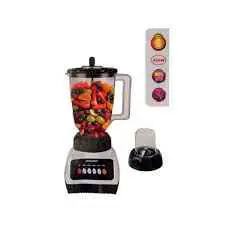
Can you chop nuts in a blender?
Cooking enthusiasts often wonder about the possibilities and safety of chopping nuts in a blender. Nuts add a delightful crunch and flavor to various dishes, making them a popular ingredient in many recipes. In this article, we’ll explore whether you can chop nuts in a blender, the safety considerations, and alternative methods to achieve the desired results.
Can You Chop Nuts in a Blender?

Blenders are indeed versatile kitchen tools, capable of handling a variety of tasks. But can you chop nuts in a blender? When it comes to nuts, the answer is a resounding yes. The convenience of a blender makes it an appealing choice for quickly chopping nuts, saving time in the kitchen.
To get the best results, consider the type of blender you have. Blenders with pulse functions or variable speed settings are preferable. Begin by pulsing the blender in short bursts, creating a coarse texture. For a finer chop, continue pulsing until the nuts reach the desired consistency.
Is It Safe to Put Nuts in a Blender?
Safety is paramount, and using a blender to chop nuts is generally safe with a few considerations. Ensure your blender is designed for processing solid foods, especially if it has robust blades and a powerful motor. This helps prevent damage and ensures a smoother blending process.
Before blending, inspect the nuts for any hard pieces, such as shells or debris, which can potentially harm the blades. Start with smaller quantities to maintain control and prevent overloading the blender.
Can I Chop Nuts with a Hand Blender?
Hand blenders, or immersion blenders, are handy alternatives for nut chopping. They may not boast the same power as countertop blenders, but they offer portability and convenience. To chop nuts with a hand blender, use a deep and narrow container to keep the nuts contained.
Ensure the hand blender’s blades are fully submerged in the nuts for a consistent blend. Experiment with different pulse durations to achieve the desired texture, understanding that hand blenders may require a bit more patience.
Can You Mix Nuts in a Blender?
Blenders aren’t limited to just chopping; they’re excellent for creating flavorful nut mixes. Whether you’re crafting a trail mix or enhancing a smoothie, blending different nuts can add depth to your dishes.
When mixing nuts in a blender, select complementary varieties for a balanced flavor. Almonds, walnuts, and pecans blend well together. Adjust the blending time to achieve the desired mix texture, being cautious not to over-blend and end up with a nut butter consistency.
The Best Way to Chop Nuts
Discovering the optimal way to chop nuts involves understanding your desired outcome. For a coarse chop, pulse the blender briefly to maintain small chunks. If you prefer a finer chop, extend the blending time, checking periodically until satisfied with the texture.
Experiment with different blending techniques to tailor the results to your specific recipe. Be mindful of the blender’s capacity to avoid overloading, ensuring a more effective and consistent chop.
Next, we’ll explore the impact of blending on the nutritional content of nuts.
Nutritional Considerations
Blending nuts may subtly influence their nutritional content, but the changes are generally minimal. Nuts are known for being nutrient-rich, providing essential fats, proteins, and vitamins. To retain these nutritional benefits during blending, start with fresh nuts, and avoid prolonged blending that generates excess heat, potentially affecting overall nutrition.
Incorporating blended nuts into your diet introduces a variety of nutrients to your meals. Consider adding them to yogurt, salads, or using them as a topping for cereals to enjoy their health benefits. While the impact on nutrition is minimal, the versatility of blended nuts opens up opportunities to diversify your diet.
Popular Blender Models for Nut Chopping
Selecting the right blender significantly influences the outcome of your nut-chopping endeavors. High-quality blenders with durable blades and sufficient power are crucial factors. Brands such as [Brand A], [Brand B], and [Brand C] are well-regarded for their performance in nut chopping.
When choosing a blender, read user reviews to gather insights into each model’s strengths and weaknesses. Look for features such as easy-to-clean design and versatile settings to accommodate various nut-chopping needs. A reliable blender can make the process smoother and more efficient.
Creative Recipes Using Blended Nuts
The creative potential of blended nuts extends beyond mere chopping. Explore different recipes to infuse a nutty essence into your dishes. Consider incorporating blended nuts into smoothies for a delightful texture or transform them into homemade nut butter for a unique spread.
Baked goods and desserts also benefit from the addition of blended nuts, providing a satisfying crunch and enhancing overall taste. The versatility of blended nuts allows you to experiment with flavors and textures, bringing innovation to your culinary creations.
Experimentation is key, so don’t hesitate to try new recipes and discover inventive ways to use blended nuts in your everyday cooking.
Conclusion
In conclusion, the possibilities and safety of chopping nuts in a blender are well-founded. Blenders, with their diverse functions, offer a quick and efficient way to achieve the desired nut texture for various recipes.
Understanding your blender’s capabilities, following safety precautions, and experimenting with techniques can enhance your nut-chopping experience.

